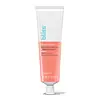What's inside
What's inside
 Key Ingredients
Key Ingredients

 Benefits
Benefits

 Concerns
Concerns

 Ingredients Side-by-side
Ingredients Side-by-side

Water
Skin ConditioningTridecyl Stearate
EmollientNeopentyl Glycol Dicaprylate/Dicaprate
EmollientPropanediol
SolventSqualane
EmollientStearic Acid
CleansingGlyceryl Stearate Se
EmulsifyingTridecyl Trimellitate
EmollientCetearyl Alcohol
EmollientCetyl Palmitate
EmollientPanthenol
Skin ConditioningTocopherol
AntioxidantMagnesium Carboxymethyl Beta-Glucan
Skin ConditioningLactococcus Ferment Lysate
Skin ConditioningCeramide NP
Skin ConditioningBeta-Carotene
Skin ConditioningRosmarinus Officinalis Leaf Extract
AntimicrobialHelianthus Annuus Extract
EmollientDaucus Carota Sativa Root Extract
Skin ConditioningOryza Sativa Bran Extract
Skin ConditioningChlorella Vulgaris Extract
Skin ConditioningButyrospermum Parkii Butter
Skin ConditioningGlycine Soja Oil
EmollientZinc PCA
HumectantLactic Acid
BufferingAllantoin
Skin ConditioningGlycerin
HumectantCaprylyl Glycol
EmollientCaprylic/Capric Triglyceride
MaskingHydrogenated Phosphatidylcholine
EmulsifyingAcrylates/C10-30 Alkyl Acrylate Crosspolymer
Emulsion StabilisingSodium Stearoyl Glutamate
CleansingCetearyl Glucoside
EmulsifyingHexylene Glycol
EmulsifyingPentylene Glycol
Skin ConditioningTetrasodium Glutamate Diacetate
Phenoxyethanol
PreservativeEthylhexylglycerin
Skin ConditioningSodium Benzoate
MaskingChlorphenesin
AntimicrobialSodium Chloride
MaskingSodium Hydroxide
BufferingWater, Tridecyl Stearate, Neopentyl Glycol Dicaprylate/Dicaprate, Propanediol, Squalane, Stearic Acid, Glyceryl Stearate Se, Tridecyl Trimellitate, Cetearyl Alcohol, Cetyl Palmitate, Panthenol, Tocopherol, Magnesium Carboxymethyl Beta-Glucan, Lactococcus Ferment Lysate, Ceramide NP, Beta-Carotene, Rosmarinus Officinalis Leaf Extract, Helianthus Annuus Extract, Daucus Carota Sativa Root Extract, Oryza Sativa Bran Extract, Chlorella Vulgaris Extract, Butyrospermum Parkii Butter, Glycine Soja Oil, Zinc PCA, Lactic Acid, Allantoin, Glycerin, Caprylyl Glycol, Caprylic/Capric Triglyceride, Hydrogenated Phosphatidylcholine, Acrylates/C10-30 Alkyl Acrylate Crosspolymer, Sodium Stearoyl Glutamate, Cetearyl Glucoside, Hexylene Glycol, Pentylene Glycol, Tetrasodium Glutamate Diacetate, Phenoxyethanol, Ethylhexylglycerin, Sodium Benzoate, Chlorphenesin, Sodium Chloride, Sodium Hydroxide
Water
Skin ConditioningParaffinum Liquidum
EmollientGlycerin
HumectantPetrolatum
EmollientStearic Acid
CleansingGlyceryl Stearate
EmollientSesamum Indicum Seed Oil
EmollientUrea
BufferingLanolin Alcohol
EmollientTriethanolamine
BufferingHordeum Vulgare Extract
EmollientCucumis Sativus Fruit Extract
EmollientHelianthus Annuus Seedcake
AbrasivePropylene Glycol Dicaprate
EmollientSodium Hyaluronate
HumectantButylene Glycol
HumectantPentylene Glycol
Skin ConditioningTrisodium EDTA
Phenoxyethanol
PreservativeCI 15985
Cosmetic ColorantCI 19140
Cosmetic ColorantCI 17200
Cosmetic ColorantWater, Paraffinum Liquidum, Glycerin, Petrolatum, Stearic Acid, Glyceryl Stearate, Sesamum Indicum Seed Oil, Urea, Lanolin Alcohol, Triethanolamine, Hordeum Vulgare Extract, Cucumis Sativus Fruit Extract, Helianthus Annuus Seedcake, Propylene Glycol Dicaprate, Sodium Hyaluronate, Butylene Glycol, Pentylene Glycol, Trisodium EDTA, Phenoxyethanol, CI 15985, CI 19140, CI 17200
 Reviews
Reviews

Ingredients Explained
These ingredients are found in both products.
Ingredients higher up in an ingredient list are typically present in a larger amount.
Glycerin is already naturally found in your skin. It helps moisturize and protect your skin.
A study from 2016 found glycerin to be more effective as a humectant than AHAs and hyaluronic acid.
As a humectant, it helps the skin stay hydrated by pulling moisture to your skin. The low molecular weight of glycerin allows it to pull moisture into the deeper layers of your skin.
Hydrated skin improves your skin barrier; Your skin barrier helps protect against irritants and bacteria.
Glycerin has also been found to have antimicrobial and antiviral properties. Due to these properties, glycerin is often used in wound and burn treatments.
In cosmetics, glycerin is usually derived from plants such as soybean or palm. However, it can also be sourced from animals, such as tallow or animal fat.
This ingredient is organic, colorless, odorless, and non-toxic.
Glycerin is the name for this ingredient in American English. British English uses Glycerol/Glycerine.
Learn more about GlycerinPentylene glycol is typically used within a product to thicken it. It also adds a smooth, soft, and moisturizing feel to the product. It is naturally found in plants such as sugar beets.
The hydrophilic trait of Pentylene Glycol makes it a humectant. As a humectant, Pentylene Glycol helps draw moisture from the air to your skin. This can help keep your skin hydrated.
This property also makes Pentylene Glycol a great texture enhancer. It can also help thicken or stabilize a product.
Pentylene Glycol also acts as a mild preservative and helps to keep a product microbe-free.
Some people may experience mild eye and skin irritation from Pentylene Glycol. We always recommend speaking with a professional about using this ingredient in your routine.
Pentylene Glycol has a low molecular weight and is part of the 1,2-glycol family.
Learn more about Pentylene GlycolPhenoxyethanol is a preservative that has germicide, antimicrobial, and aromatic properties. Studies show that phenoxyethanol can prevent microbial growth. By itself, it has a scent that is similar to that of a rose.
It's often used in formulations along with Caprylyl Glycol to preserve the shelf life of products.
Stearic Acid is a fatty acid. It is an emollient, emulsifier, and texture enhancer.
As an emollient, stearic acid helps soften skin. It aids the skin's protective barrier by preventing water loss. It also provides a gentle cleansing effect without stripping away natural oils.
Stearic acid may also be used to enhance the texture of products. It can add volume and stabilize ingredients such as water and oil. This can help water and oil ingredients from separating.
Sources of stearic acid include animal or vegetable fats/oils such as coconut or shea. It can be naturally found in butter, cocoa butter, shea butter, vegetable fats, and animal tallow.
This ingredient may not be Malassezia folliculitis, or fungal-acne safe.
Learn more about Stearic AcidWater. It's the most common cosmetic ingredient of all. You'll usually see it at the top of ingredient lists, meaning that it makes up the largest part of the product.
So why is it so popular? Water most often acts as a solvent - this means that it helps dissolve other ingredients into the formulation.
You'll also recognize water as that liquid we all need to stay alive. If you see this, drink a glass of water. Stay hydrated!
Learn more about Water